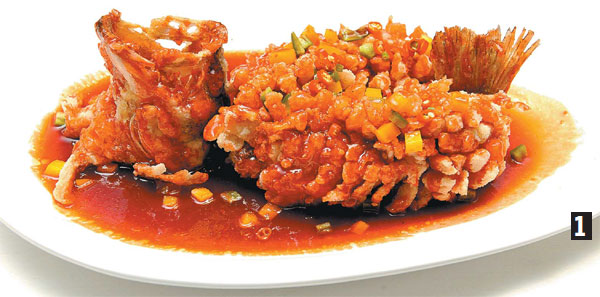An eastern renaissance of art in food
"For the people, food is heaven," said Sima Qian, an historian from the Western Han Dynasty (206 BC-AD 24). Today, these words still ring true. The Chinese people's respect and passion for food is firmly entrenched in the cultural landscape, with a culinary scene that reflects the vast geographical footprint of the world's most populous country. Pauline D. Loh offers a view from the table.
This is where musicians, poets and princes used to frolic, enjoying the picturesque scenery as much as the company of their favorite courtesans.
Where such beauty exists, fine cuisine must follow.

In the elegant cities of Yangzhou, Suzhou and Hangzhou, the cuisine reflects the past with its lyrical presentations and soft, subtle flavors.
It is cooking that distills the essence of good taste and the finest kitchen skills.
It is food eaten while poets sipped wine, composed odes and dedicated prose and poetry to the dishes before them and the ladies beside them.
Even the Qing Emperor Qianlong was tempted enough to play truant from his royal duties and escaped on at least seven occasions to this playground in Jiangnan, "south of the river".
Indeed, the Yangtze River is often used as a convenient marker in the culinary compass point. In this case, the area we are looking at is the fertile district of lakes and rivers along the eastern board of China.
Here, the wealthy salt merchants of Yangzhou showed off their opulence with banquets cooked by coveted private chefs.
Here, talented courtesans and embroidery artists of Suzhou showed off their skills in beautifully landscaped gardens with pavilions built on water.
Here, too, on the West Lake in Hangzhou, romance and fairy tales colored local epicurean legends.
Collectively, the delicate kitchen art of the region is known as eastern China's Huaiyang cuisine, one of the eight mainstream cooking styles.
Its lighter, healthier qualities have found favor even in modern day Beijing and recent state banquets at the Great Hall of the People have showed a definite slant toward Huaiyang cuisine.
Named after the historical cities of Huai'an and Yangzhou, this cuisine is ancient - having originated in the Spring and Summer Period, evolving through the Sui and Tang era and flourishing in the Ming and Qing dynasties.
It is all about the knife work, and the skills involved challenge the most amazing acrobats. Huaiyang chefs have been known to shred bean curd placed upon a taut balloon.
To illustrate the point, let us look at the preparation of Wensi Doufu, a bean curd dish named Delicate Contemplation.
A tender block of tofu is first sliced and then slivered so fine that the chef needs to feel, rather than see what he is cutting.
The processed bean curd is then slid into a bowl of water so it will fan out into threads. It is then poached in a superior stock slightly thickened so the tofu seems suspended in mid-broth.
Such elegant knife work generally takes seven years of intense concentration to perfect, not to mention countless blocks of shredded tofu.
Another typical Huaiyang dish is the aptly named giant meatball known as the Lion's Head, shizitou.
Unlike other recipes, the meat here is hand cut, never minced, so each tiny cube has the ideal proportion of fat and lean. The meatball is then shaped and dropped into barely simmering stock to cook.
It is also a dish that tests the chef's mastery of the cooking fire.
Too high a heat and the meat gets tough, too low and it will not cook through to the center. Too long on the fire, the meat is bleached of its natural juices. Not long enough, you get minced meat soup when you try to serve it.
It is something only the most dedicated control freak can master, yet the perfect meatball is succulent and well-formed but falls apart as the chopstick pierces the outer crust.
Often, the meatballs are sweetened with the addition of crabmeat, another regional specialty from the lakes.
Another example of fine knife work can be seen in the ubiquitous sweet and sour "squirrel fish" where a whole mandarin fish is expertly filleted so it curls up like a squirrel's tail when it is dropped into boiling oil.
The red sauce was traditionally colored by candied haw, although current chefs may use commercial tomato ketchup.
Not every dish depends on how expensive the ingredient is. One of the most popular dishes in Yangzhou is dazhu gansi, or shredded hard bean curd cakes.
A bean curd cake 2 mm thick must be sliced horizontally into 32 layers before being cut into fine noodles poached in stock.
As you can tell by now, poaching is a favorite cooking method. What you don't know is that the Huaiyang chef actually differentiates at least four different ways to poach, of which there is no way to translate.
The English kitchen lexicon has yet to catch up with the Huaiyang chef.
Best known dishes of Huaiyang cuisine:
Wensi Doufu
Any other interpretation of the name would cause its beauty to be lost in translation. But this is probably the cuisine's most representative soup. It is a savory broth that has the finest threads of tofu floating in it.
Lion's head meatball
There is a more elegant name but most diners remember this giant meatball as the lion's head, which describes both its size and reputation.
Yaorou or pulled pork jelly
This is a jellied meat that is very like the German head cheese, except it is more subtly favored.
Yangzhou fried rice
Everybody's made fried rice, yes? But the Huaiyang chef's version can only be truly appreciated when a single grain is dissected and the white of the rice is totally enveloped in a yellow coating of egg. Every single grain. They call this "gold coating the silver".


















